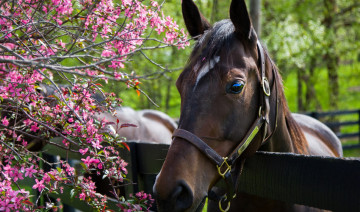As winter's chill gives way to the warmth of spring, horse owners eagerly anticipate the shift in seasons. However, this change also brings about adjustments in equine care routines. Navigating the transition from winter to spring is crucial for maintaining the health and happiness of our beloved four-legged friends. In this blog, we'll explore the seasonal changes that impact horses and provide insights on safely guiding your equine companion through the blossoming days of spring.
1. Understanding the Seasonal Shift:
Spring brings changes in temperature, daylight hours, and forage availability. Understanding how these factors influence your horse's metabolism and behavior is the first step in facilitating a smooth transition.
2. Adjusting Feed for Spring:
With the arrival of spring, pasture grasses become more abundant. Gradually introduce horses to fresh pasture to prevent digestive upset. Monitor their weight and condition, adjusting concentrate feeds accordingly. Consult with your veterinarian for a balanced nutrition plan.
3. Managing Weight and Exercise:
Winter coats may linger as spring temperatures rise. To avoid overheating during exercise, gradually acclimate horses to increased workloads and consider body clipping if needed. Monitor weight changes closely, ensuring a healthy balance between pasture intake and supplemental feeding.
4. Monitoring Hoof Health:
Spring's softer ground can contribute to changes in hoof conditions. Regularly check hooves for signs of thrush, cracks, or imbalances. Adjust your horse's trimming schedule as needed and consider applying hoof protection if transitioning from soft to rocky terrain.
5. Addressing Allergies and Respiratory Health:
Spring blooms can trigger allergies in horses, leading to respiratory issues. Keep an eye out for signs of nasal discharge, coughing, or labored breathing. If necessary, consult with your veterinarian for allergy management strategies and consider adjusting turnout areas if environmental allergens are identified.
6. Parasite Control and Deworming:
Spring is an opportune time for reviewing your horse's parasite control program. Conduct fecal egg counts and work with your veterinarian to develop a targeted deworming plan based on your horse's needs and pasture management practices.
7. Maintaining Hydration:
As temperatures rise, ensure your horse stays adequately hydrated. Clean, fresh water should be readily available. Regularly clean water buckets and troughs to encourage consistent water intake.
8. Transitioning to Spring Turnout:
Gradually reintroduce horses to increased turnout as pastures become lush. Monitor for signs of laminitis, a condition often associated with rapid consumption of rich spring grass. Utilize grazing muzzles if necessary and consider implementing controlled turnout times.
9. Veterinary Check-Up:
Schedule a spring check-up with your veterinarian. Discuss vaccination updates, dental care, and any specific concerns related to your horse's health. Early detection of potential issues is key to preventing more significant problems down the road.
10. Observation and Adaptation:
Above all, closely observe your horse's behavior, body condition, and overall well-being. Horses may show subtle signs of discomfort or adjustment during seasonal transitions. Be prepared to adapt your care routine based on their individual needs.
Conclusion:
Guiding your equine companion through the seasonal transition from winter to spring requires a blend of proactive care, vigilance, and adaptability. By adjusting feeding plans, monitoring weight and hoof health, addressing allergies, and maintaining regular veterinary care, you can ensure a smooth and healthy transition for your horse. As the days lengthen and temperatures rise, take joy in witnessing your equine friend embrace the vibrancy of spring with vitality and grace.






Comments